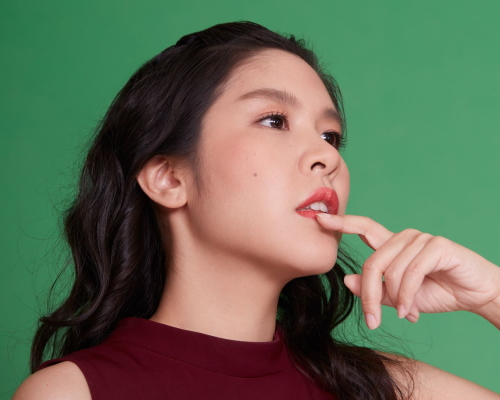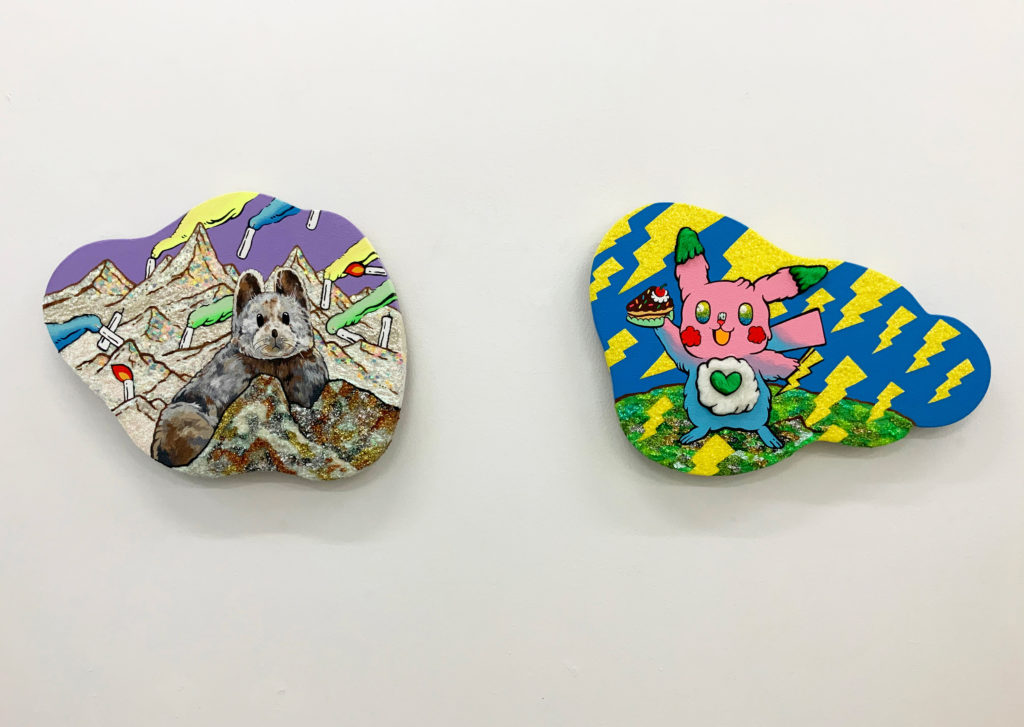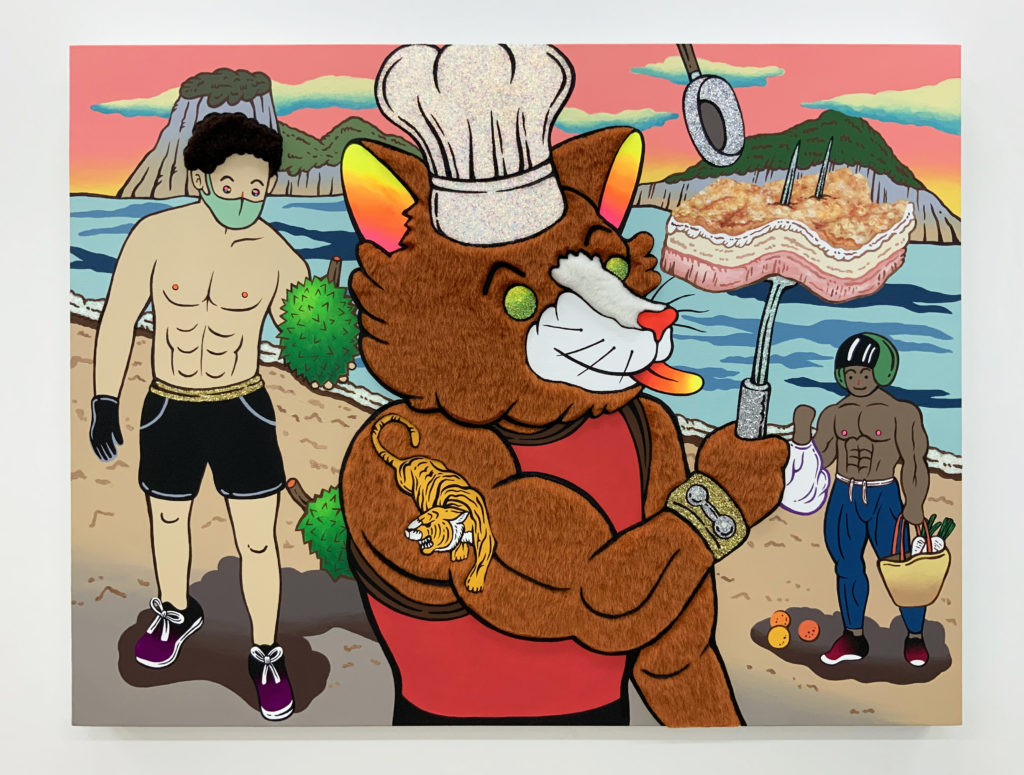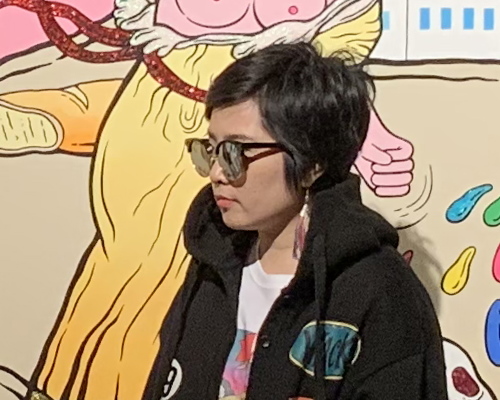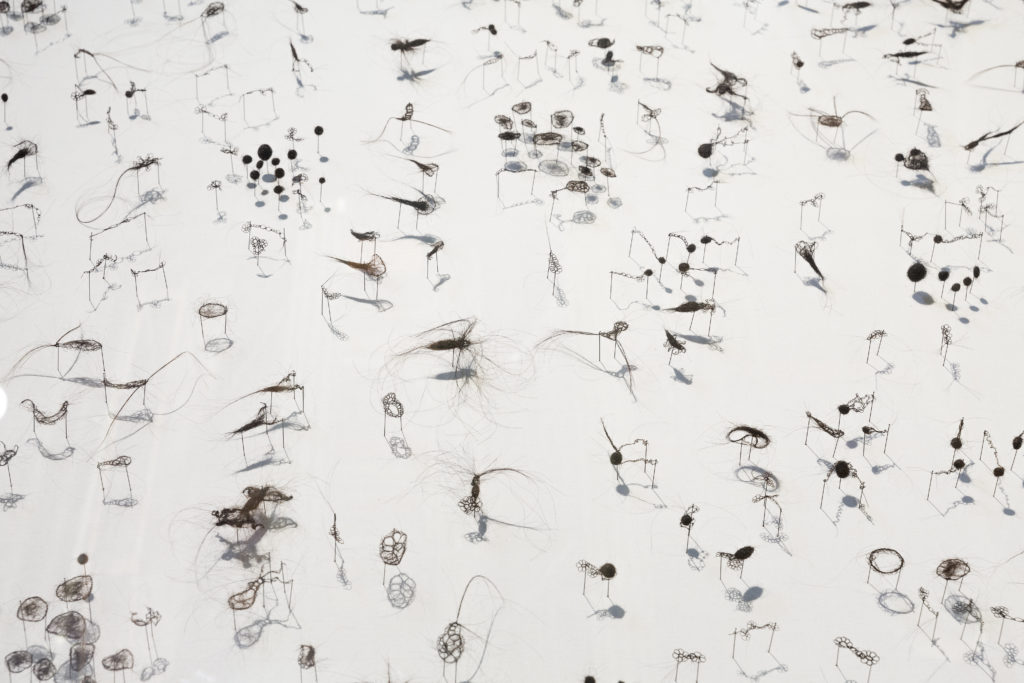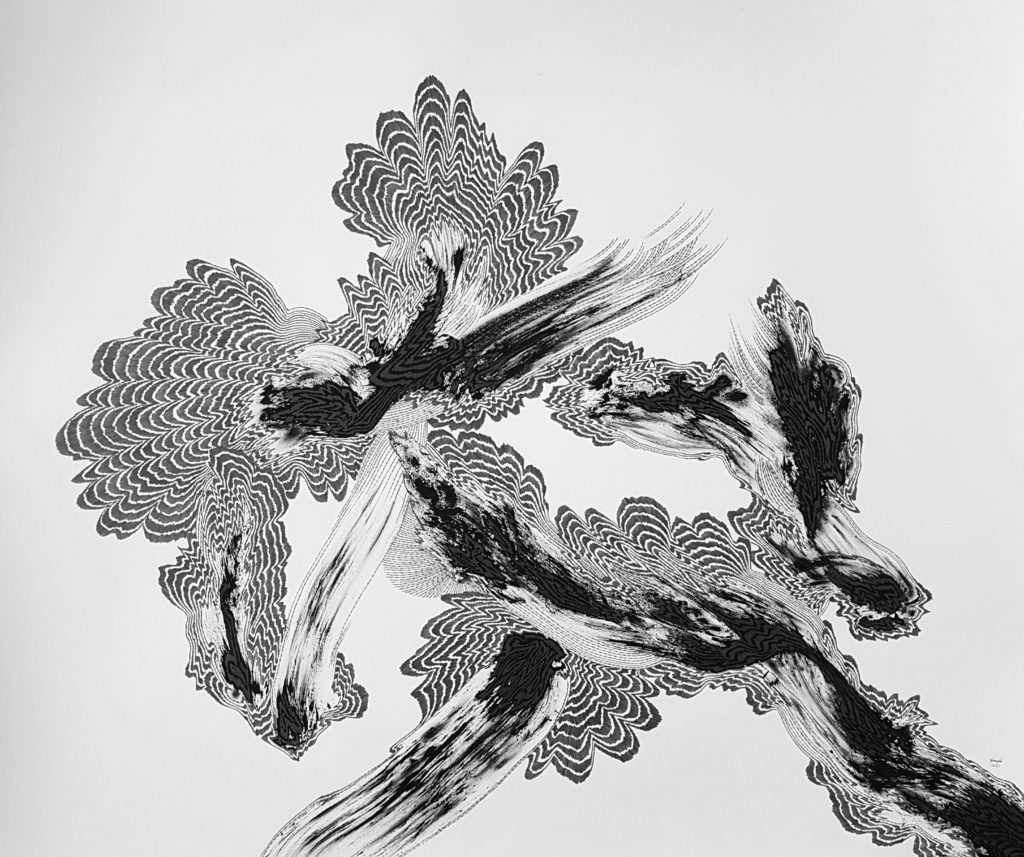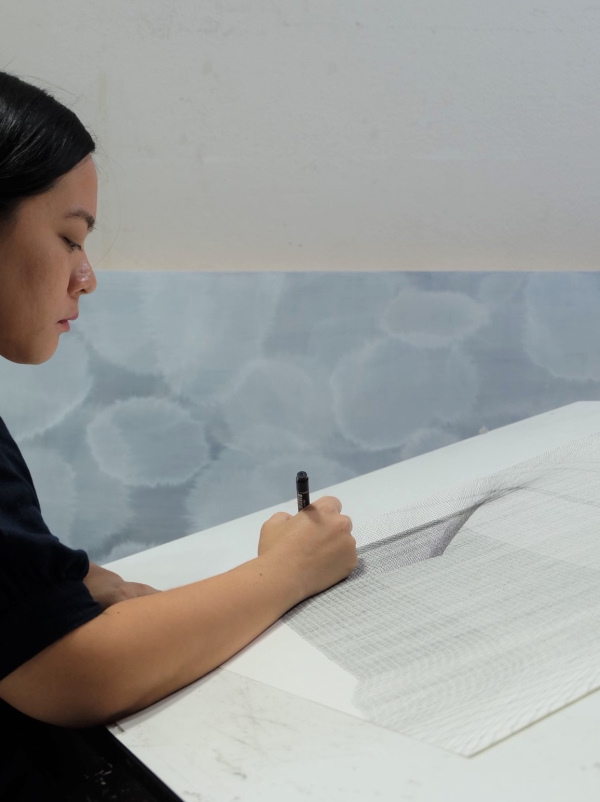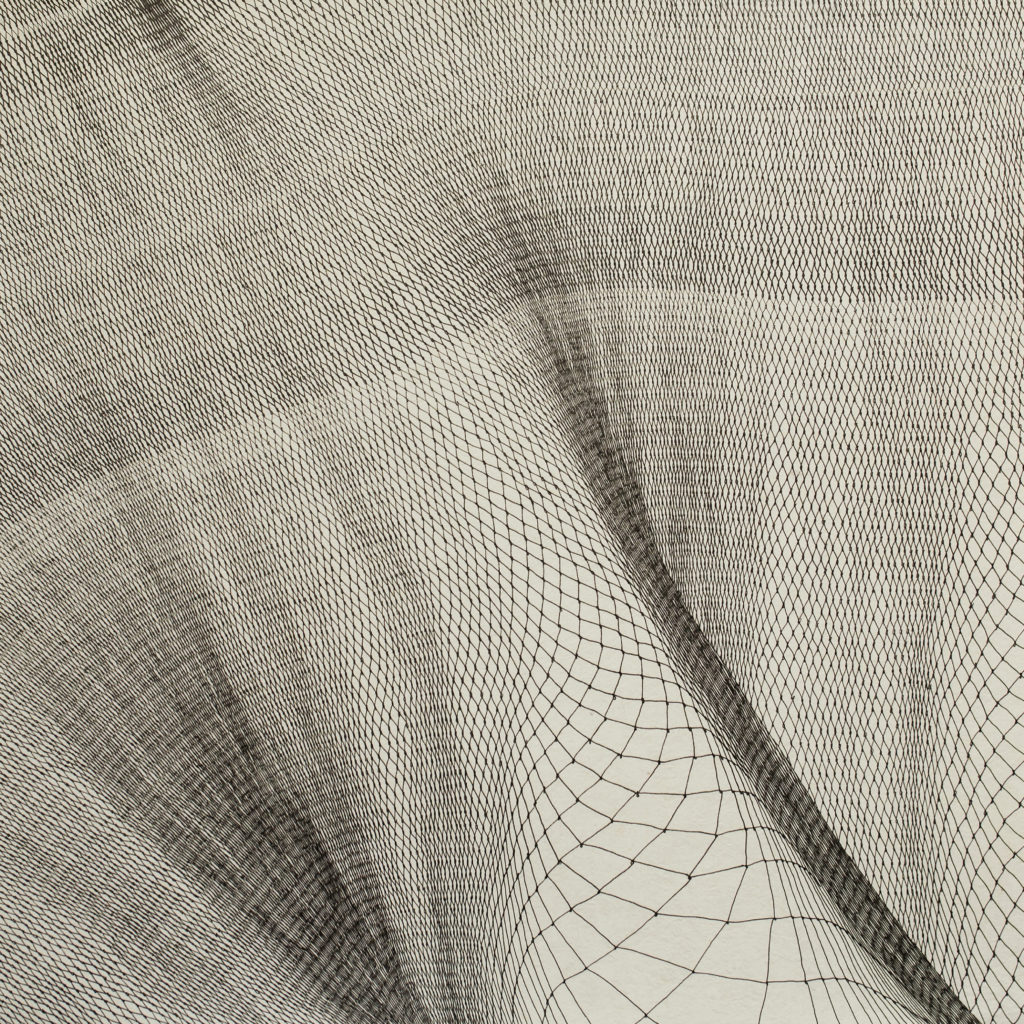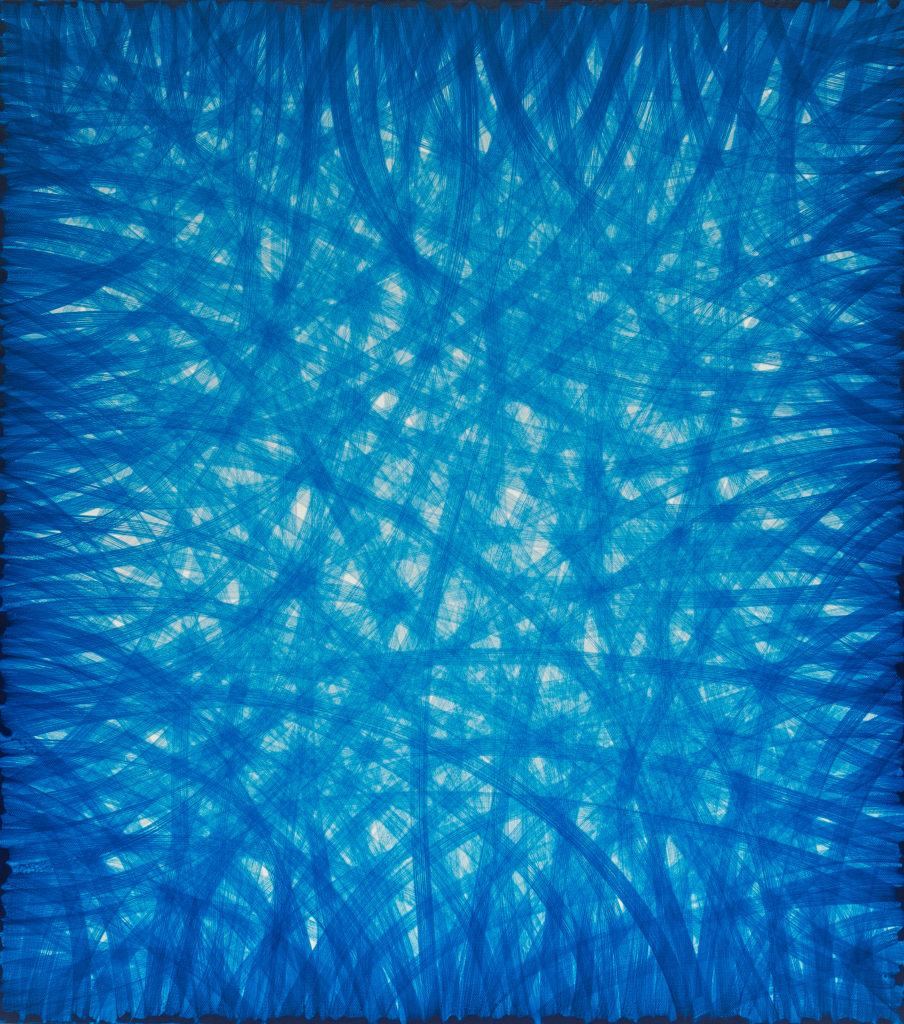by Arnaud Lebecq
Dans une société thaïlandaise basée sur le patriarcat, la situation des femmes dans la communauté artistique Thaïlandaise a radicalement changé au cours des trente dernières années. Dans les années 1970, les occupations familiales étant bien plus importantes, les femmes n’avaient pas le temps de s’adonner à la création artistique.
Les années 1990 ont été marquées par des changements positifs pour les femmes et l’art en Thaïlande : des programmes artistiques universitaires ont encouragé les artistes étrangers à venir dans le pays, y compris des femmes artistes apportant leur soutien et encourageant les artistes locales ; l’art étant devenu un choix plus « acceptable », les inscriptions de femmes dans les écoles d’arts ont augmenté; la structure globale de l’économie a évolué ; un nombre croissant de femmes artistes thaïlandaises sélectionnées pour participer à des expositions internationales a entrainé une motivation croissante au sein de la communauté artistique féminine.
Dans ce contexte, les femmes ont trouvé une place de choix au sein de la communauté artistique en Thaïlande et à l’international.
ACA project vous invite à découvrir quatre artistes Thaïlandaises récemment invitées par la galerie arnaud Lebecq à Paris, galerie dédiée aux rayonnement des scènes artistiques de l’Asie du Sud-Est.
In a Thai society based on patriarchy, the situation of women in the Thai art community has changed drastically over the past thirty years. During the 70’s, with family occupations being far more important, women did not have the time for artistic creation.
The 90’s saw positive changes for women and art in Thailand: university art programs encouraged foreign artists to come to the country, including women artists supporting and encouraging local artists; as art became a more « acceptable » choice, female applications in art schools increased; the overall structure of the economy changed and a growing number of Thai women artists selected to participate in international exhibitions led to a stronger motivation within the women’s art community. In this context, women have found a significant place in the art community in Thailand and internationally.
ACA project invites you to discover four Thai artists recently invited by the arnaud Lebecq Gallery in Paris, a gallery dedicated to the Southeast Asian art scenes.
Kawita Vatanajyankur
Née en 1987, Kawita Vatanajyankur qui a étudiée en Australie pour venir ensuite s’installer à Bangkok, est une artiste performeuse engagée. Son travail dans lequel elle se met en scène reflète son engagement. Basé sur la répétitivité du mouvement, il met en avant le cercle vicieux des sujets sociétaux abordés. Elle ne prône ni la violence ni la révolte mais le dialogue entre les différents acteurs de la société.
Dans sa série présentée à Paris en 2020, Kawita Vatanajyankur immerge le spectateur dans une thématique universelle qu’est celle de la condition de la femme dans la vie domestique. S’inspirant des images publicitaires assénées par nos sociétés d’hyperconsommation, l’intensité colorimétrique de ses créations renforce l’impact et l’engagement de son travail. Soumission, force, abjection, absurdité et implication personnelle de l’artiste génèrent tensions et interactions avec le public.
« J’ai créé « Sponge », une œuvre vidéo performative complétant ma série « Tools » (Outils), dans laquelle mon corps a été contraint de travailler comme un objet dans un environnement domestique. Les travaux ménagers, même s’ils sont généralement considérés comme une œuvre abstraite, sont sans fin, épuisants, physiquement et psychologiquement. Souvent considérés comme un travail féminin non reconnu, ils requièrent force, puissance et endurance. Dans ce travail réalisé pendant le confinement, j’ai lentement transformé mon corps en éponge pour nettoyer la vaisselle. L’action et le mouvement répétitif du corps ainsi que le visage crispé visent à me transformer en une éponge à vaisselle parfaite grâce à un schéma d’étape méditative. Parfois, le visage est forcé et compressé pour être trempé dans le savon avant de revenir et être pressé contre la vaisselle sans répit, violemment » explique Kawita Vatanajyankur.
Born in 1987, Kawita Vatanajyankur, who studied in Australia then settled in Bangkok, is a committed performing artist. Her work in which she puts herself on stage reflects her commitment. Based on the repetitiveness of movements, it highlights the vicious circle of the societal topics she raises. The artist promotes neither violence nor revolt but dialogue between the different social actors. In her series presented in Paris in 2020, Kawita Vatanajyankur immerses the viewer in the universal subject of women’s condition in domestic life. Inspired by the promotional images imposed by our hyper-consumption societies, the color intensity of her creations reinforces both the impact and the commitment of her work. Submission, strength, abjection, absurdity and personal involvement of the artist generate tension and interaction with the audience.
« I created « Sponge », a performative video work that completes my « Tools » series, in which my body was forced to operate as an object in a domestic environment. Housework, while usually considered as an abstract work, is endless, exhausting, physically and psychologically. Often seen as unrecognized women’s work, it requires strength, power and endurance. In this work made during the confinement, I slowly transformed my body into a sponge to clean the dishes. The repetitive action and movement of the body as well as my tensed face are intended to transform me into a perfect dish washing sponge through a meditative step process. Sometimes my face is forced and compressed to be immersed in the soap before coming back and being pressed against the dish without rest, violently. » explains Kawita Vatanajyankur.
Yuree Kensaku
Artiste d’origines thaïlandaise et japonaise, Yuree Kensaku est née en 1979 à Bangkok où elle vit et travaille.
Dans son travail autour de la peinture et de la sculpture, l’artiste utilise souvent des couleurs électrisantes, un sens de l’humour affirmé et des personnages de dessins animés aux allures enfantines avec une touche sombre.
Très divertissantes à première vue, les œuvres de Yuree Kensaku présentent constamment des commentaires audacieux et critiques sur la société, ainsi qu’une introspection intime sur sa vie personnelle en tant que femme artiste.
« La fuite, l’évitement de la confrontation, la violence, la peur, la frustration, tant personnelle que sociale, sont dissimulés sous une simplification excessive de la vérité et des couleurs gaies, un enrobage de sucre cachant une amertume dissimulée. C’est ainsi que je transforme les problèmes qui m’entourent en divers types d’art tout au long de ma carrière artistique.
– « Cosplay Fever » : le confinement est une période difficile pour les Thaïlandais mais nous ne perdons jamais notre sens de l’humour. J’ai utilisé plusieurs images : une image d’une infirmière utilisant un thermomètre électronique sur une personne déguisée en Pikachu, une image de Barbapapa – un personnage de dessin animé télévisé de mon enfance, et une troisième image du Petit Prince – le personnage d’un livre que j’ai lu il y a longtemps. Dans mon travail, ces personnages font tous la queue pour faire vérifier leur température.
– Dans « Endangered Ili Pika and Popular Pikachu », alors que Pokémon, très ancré dans la culture des jeunes, fête ses 25 ans, j’ai peint un personnage très similaire à Pikachu, le personnage le plus reconnaissable de Pokémon, tenant un gâteau avec enthousiasme. L’autre partie du diptyque représente Il Pika, un petit mammifère retrouvé sur une falaise rocheuse à Tianshan, en Chine. Les Il Pikas seraient la source d’inspiration pour Pikachu et sont dangereusement en voie d’extinction », raconte Yuree Kensaku.
Yuree Kensaku, an artist of Thai and Japanese origin, was born in 1979 in Bangkok where she now lives and works. In her work focusing on painting and sculpture, the artist often uses electrifying colors, a strong sense of humor and childlike cartoon characters with a dark tone. Highly entertaining at first glance, Yuree Kensaku’s works constantly present both strong and critical comments on the society, as well as an intimate introspection into her personal life as a female artist.
« Escape, avoiding confrontation, violence, fear, frustration, both personal and social, are hidden under an over-simplification of truth and cheerful colors, a sugar coating hiding a dissimulated bitterness. This is how I transform the problems around me into various types of art throughout my artistic career.
– « Cosplay Fever »: confinement is a difficult period for Thai people but we never lose our sense of humor. I used several images: an image of a nurse operating an electronic thermometer on a person dressed as Pikachu, an image of Barbapapa – a TV cartoon character from my childhood, and a third image of the Little Prince – the hero of a book I read long ago. In my work, these figures are all queuing up to have their temperature checked.
– « In Endangered Ili Pika and Popular Pikachu », as Pokemon, which is very established in youth culture, turns 25, I painted a character very similar to Pikachu, the most recognizable Pokemon figure, holding a cake with enthusiasm. The other part of the diptych depicts Il Pika, a small mammal found on a rocky cliff in Tianshan, China. Il Pikas are said to be the inspiration for Pikachu and are dangerously close to extinction » says Yuree Kensaku.
Imhathai Suwatthanasilp
Née à Bangkok en 1981, Imhathai Suwattahnasilp obtient une licence et une maîtrise en Arts Thaïs à l’université des Beaux-Arts de Silpakorn à Bangkok. En 2006, elle participe au programme d’échange de l’École Nationale Supérieure des Beaux-Arts de Paris, en France. Depuis sa première exposition solo en 2008, Imhathai a initié un mode de création caractérisé par l’utilisation des cheveux humains qu’elle tisse, crochète, brode ou lace dans des œuvres bi- et tridimensionnelles, calmes et intimes ; elles sont une réflexion sur la nature des liens familiaux, la vie domestique, le corps féminin et l’identité féminine. Ses créations sur papier et sur toile qu’elle développe ensuite, reflètent les spectres magnifiés des paysages et de la nature pour évoluer autour de l’intimité et de la contemplation.
« Je me suis installée à Lampoon en 2018 et mon studio est situé au milieu d’une nature abondante. Je découvre la croissance des champignons sur le sol et sur l’écorce des arbres, la floraison des fleurs de riz, les abeilles qui créent leurs ruches, les insectes qui construisent leurs nids, les termites qui se débarrassent de leurs ailes, la sensation du vent froid et de la lumière chaude du soleil, de la pluie qui tombe et du bel arc-en-ciel en toutes saisons. Ces choses évoquent en moi un ressenti que je transcris dans mes œuvres comme témoin de la mémoire. Je réalise que la nature et l’homme vivent en harmonie. Depuis plusieurs années, je m’intéresse au processus de dessin sur papier avec des traces qui apparaissent sur la surface plane aussitôt après la création. Cependant, le dessin sur toile est quelque chose de très différent ; avec des équipements traditionnels de dessin, j’ai suivi des méthodes et des processus jusqu’à ce que je découvre le monoprint de cheveux sur toile. Ensuite, je le complète par le dessin au fusain et la peinture acrylique », déclare Imhathai Suwatthanasilp.
Born in Bangkok in 1981, Imhathai Suwattahnasilp received her BFA and MFA in Thai Art from the Silpakorn University of Fine Arts in Bangkok. In 2006, she participated in the exchange program at the École Nationale Supérieure des Beaux-Arts in Paris, France. Since her first solo exhibition in 2008, Imhathai has initiated a mode of creation characterized by the use of human hair that she weaves, crochets, embroiders or laces into quiet and intimate two- and three-dimensional works; they mirror the nature of family ties, domestic life, the female body and female identity. Her creations on paper and canvas, that she later develops, reflect the magnified spectra of landscapes and nature evolving around intimacy and contemplation.
« I moved to Lampoon in 2018 and my studio is located in the middle of abundant nature. I discovered the growth of mushrooms on the ground and on the bark of trees, the blooming of rice flowers, the bees creating their hives, the insects building their nests, the termites shedding their wings, the feeling of the cold wind and the warm light of the sun, the falling rain and the beautiful rainbow in all seasons. These things bring up feelings that I transcribe in my works as a witness of memory. I realize that nature and man live in harmony. For several years, I have been interested in the process of drawing on paper with the traces that appear on the flat surface immediately after the creation. However, drawing on canvas is something very different; with traditional drawing equipment, I followed methods and processes until I discovered the monoprint of hair on canvas. Then I complete it with charcoal drawing and acrylic painting. » declares Imhathai Suwatthanasilp.
Jiratchaya Pripwai
Née en 1983, Jiratchaya Pripwai est une artiste basée à Chiang Mai. Elle développe une pratique du dessin à l’encre reflétant ses carnets intimes. Son mode de création combinant une technique créant des dessins aux traits complexes mêlée à une technique d’écriture automatique, reflète la similitude entre les actions contrôlées par le conscient et le subconscient. Elle laisse ses expériences, ses pensées, ses sentiments, tout ce qui se mélange dans son esprit, s’exprimer à travers le mouvement de son corps en créant des lignes de manière spontanée.
« Mon travail trouve son origine dans l’état de mon esprit. Lorsque je laisse mes émotions prendre le dessus sur la raison, je deviens fatiguée et confuse. Je veux me reposer pour réfléchir et revenir à un état de tranquillité. Je commence par tracer quelques lignes. Le dessin continu et répétitif des lignes crée un mouvement doux d’un endroit vers un autre. Pendant ce processus, mon esprit vagabond devient plus calme et concentré, paisible et détendu, comme si le processus de création avait un effet thérapeutique, rétablissant l’équilibre de mon esprit ». indique Jiratchaya Pripwai.
Dans ses créations utilisant l’acrylique sur toile, Jiratchaya Pripwai reste fidèle à sa technique où le trait cède la place au coup de pinceau pour créer un entrelac de rubans accentuant la perspective et la profondeur intérieures d’un état méditatif. Le rendu flou et les variations chromatiques de ces bandelettes poussent le spectateur à s’approcher, à reculer pour faire sa mise au point sur le sujet, exprimant ainsi son attitude à porter l’attention sur ce qui se passe, à l’instant où cela se passe et rien d’autre, pour lui aussi rentrer dans un état méditatif.
Born in 1983, Jiratchaya Pripwai is a female artist based in Chiang Mai. She develops a practice of drawing with ink reflecting her intimate notebooks. Her mode of creation, combining a technique creating intricate line drawings mixed with an automatic writing technique, reveals the similarity between the actions controlled by the conscious and the subconscious. She allows her experiences, thoughts, feelings, whatever is mixed up in her mind, to be expressed through the movement of her body by creating lines in a spontaneous way.
« My work originates in the state of my mind. When I let my emotions take over my mind, I become tired and confused. I want to rest to reflect and return to a peaceful state. I begin by drawing a few lines. The continuous and repetitive drawing of lines creates a gentle movement from one place to another. During this process, my wandering mind becomes more calm and focused, peaceful and relaxed, like if the process of creation had a therapeutic effect, restoring balance to my mind » tells Jiratchaya Pripwai.
In her creations using acrylic on canvas, Jiratchaya Pripwai remains committed to her technique where line is replaced by brushstroke to create a ribbon-like pattern enhancing the inner perspective and depth of a meditative state. The blurred rendering and the chromatic variations of these ribbons encourage the viewer to come closer, to step back to focus on the subject, expressing his attitude to pay attention to what is happening, to the moment it is happening and nothing else, to finally reach a meditative state.
ACA project est une association française dédiée à la promotion de la connaissance de l’art contemporain asiatique, en particulier l’art contemporain chinois, coréen, japonais et d’Asie du sud-est. Grâce à notre réseau de bénévoles et de partenaires, nous publions régulièrement une newsletter, des actualités, des interviews, une base de données, et organisons des événements principalement en ligne et à Paris. Si vous aimez nos articles et nos actions, n’hésitez pas à nous soutenir par un don ou à nous écrire.
ACA project is a French association dedicated to the promotion of the knowledge about Asian contemporary art, in particular Chinese, Korea, Japanese and South-East Asian art. Thanks to our network of volunteers and partners, we publish a bimonthly newsletter, as well as news, interviews and database, and we organise or take part in events mostly online or in Paris, France. If you like our articles and our actions, feel free to support us by making a donation or writing to us.




